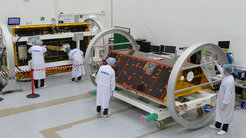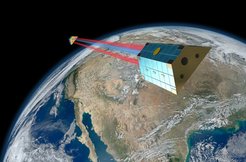GRACE Follow-On on its way to the launch
GRACE Follow-On, tandem of Earth observation satellites using gravitational-wave technology, on its way to launch in early 2018
On 12th December the twin satellites GRACE Follow-On (GRACE FO) have made their first step towards earth orbit. They flew by air freighter to the USA, where they will be launched into space from Vandenberg Air Force Base in early 2018. GRACE FO will measure the Earth‘s gravitational field to observe otherwise inacessible movements of water, ice, and land masses, which are indicators of climate change. One new component on board is a technology demonstrator developed at the Max Planck Institute for Gravitational Physics (Albert Einstein Institute; AEI). It will make the measurements even more precise and uses technology developed for the future space-based gravitational-wave detector LISA, which was tested in LISA Pathfinder.
Gravitational-wave technology from Hannover for geodesy

“GRACE Follow-On uses technology from gravitational-wave research for the very precise measurement of Earth‘s gravitational field”, says Prof. Karsten Danzmann, director at the AEI Hannover and director of the Institute for Gravitational Physics at Leibniz Universität Hannover. “Therefore, the research done at our institute has important applications in geodesy.”
GRACE Follow-On (Gravity Recovery and Climate Experiment Follow-On) is a joint US-German satellite mission of NASA‘s Jet Propulsion Laboratory (JPL) in Pasadena (California) and the German Research Centre for Geosciences (GFZ) in Potsdam. The satellites were built by Airbus in Friedrichshafen.
Satellite tandem observes the Earth‘s gravitational field

The mission consists of a satellite tandem in a low polar Earth orbit. The satellites measure their distance of about 220 kilometers to a precision of nanometers. Not only the local structure of the gravitational field but also its temporal change can be derived from the inter-satellite distance measurements. These changes of the gravitational field can in turn be used to measure indicators of climate change. These include the melting of polar ice caps and changes in subsoil water levels.
GRACE Follow-On continues the successful GRACE mission (2012-2017). Additionally, the previously used distance measurement method by microwaves will be extended by a laser interferometer, which will improve the precision to the nanometer level. The laser interferometer is a technology demonstrator onboard the satellite mission. It is a joint development by JPL and AEI Hannover. The AEI is responsible for the German part of the laser interferometer and supervises its technical realization by SpaceTech GmbH and DLR. This especially includes the optics with the steering mirror that sends the laser beam back to the distant satellite.
First laser interferometer between two satellites
To measure the inter-satellite distance in space more precise than ever with laser light, a technology developed at the AEI for the future space-based gravitational-wave detector LISA is employed. The measurement technology developed for LISA was adapted to the requirements of the GRACE FO mission. It also is a scientific premiere: For the first time a laser interferometer between distant satellites is used for length measurements.
“With GRACE Follow-On we can kill two birds with one stone: the first laser interferometer in space is an important milestone on the path to LISA, the future gravitational-wave observatory in space”, says Prof. Gerhard Heinzel, research group leader at the AEI Hannover. “We also use LISA technology to the benefit of the Earth by observing crucial indicators of climate change more precisely and understand them better.”













